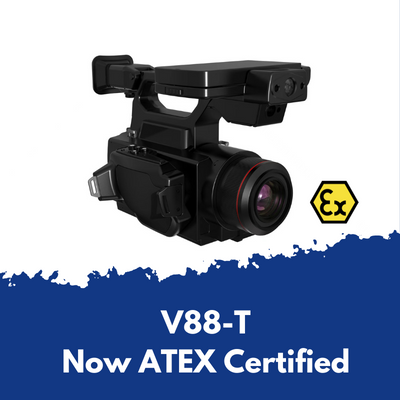
SATIR Europe are proud to announce that the V88-T is now ATEX Certified. The SATIR V88-T is a cooled thermal gas detection camera that is suitable for use in hazardous areas.
In industries where flammable gases and substances are present, which cannot been seen with the human eye, safety is of paramount importance. Implementing reliable measures to detect potentially hazardous environments is crucial for the protection of both workers and valuable assets. This is where ATEX certification and thermal gas detection cameras come into play. In this blog post, we will explore the significance of ATEX certification and how thermal gas detection cameras can help in ensuring a safe working environment.
ATEX stands for Atmosphères Explosibles, a European directive that aims to regulate the manufacture, sale, and use of equipment intended for use in potentially explosive atmospheres. The directive was implemented to ensure that products entering the market meet safety standards and do not pose a risk of causing explosions in hazardous environments.
An ATEX certification indicates that a device or equipment is compliant with the specific safety criteria outlined by the directive. The certification is divided into two categories: equipment intended for use in potentially explosive atmospheres (EX) and equipment intended for use in areas where the risk of explosion is extremely high (Ex-hazardous). The certification includes rigorous testing, inspection, and quality control to guarantee effectiveness and reliability in hazardous environments.
Thermal gas detection cameras, also known as infrared cameras, play a vital role in detecting and monitoring the presence of potentially flammable gases in industrial settings. These cameras utilize infrared imaging technology to identify gas leaks and thermal irregularities, which are often invisible to the naked eye. By providing real-time thermal imaging, they help in early detection and reduction of the risk of fire or explosions.
1. Early Detection: One of the primary benefits of thermal gas detection cameras is their ability to identify gas leaks before they become critical hazards. By recognizing thermal patterns and gas plumes, these cameras can instantly alert operators or trigger alarms, allowing prompt intervention measures.
2. Reduced False Alarms: Thermal gas detection cameras are designed to differentiate between genuine gas leaks location and gas drifting around the equipment and other sources of high-temperature anomalies. This helps in reducing false alarms, ensuring that personnel responses are directed towards genuine threats rather than wasting resources on unnecessary evacuations.
3. Enhanced Safety: Implementing thermal gas detection cameras improves overall safety by providing continuous monitoring in hazardous areas. The cameras allow operators to remotely access and monitor different locations, reducing the need for personnel to be physically present in dangerous areas.
4. Cost Reduction: By identifying and preventing gas leaks at an early stage, thermal gas detection cameras reduce the risk of costly shutdowns, equipment damages, and potential litigation arising from accidents. These cameras provide a cost-effective solution for long-term safety and peace of mind.
ATEX certification and the utilization of thermal gas detection cameras are invaluable tools in ensuring the safety of personnel and assets in industries dealing with potentially explosive atmospheres. By adhering to ATEX regulations and incorporating thermal imaging technology, businesses can significantly reduce the risk of fire, explosions, and other hazardous incidents. Investing in certified and reliable thermal gas detection cameras has become an essential aspect of safety protocols, promoting a secure working environment for all stakeholders involved.